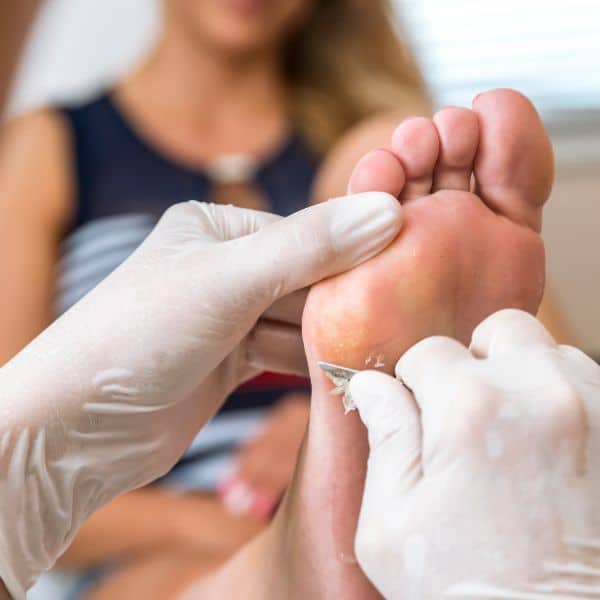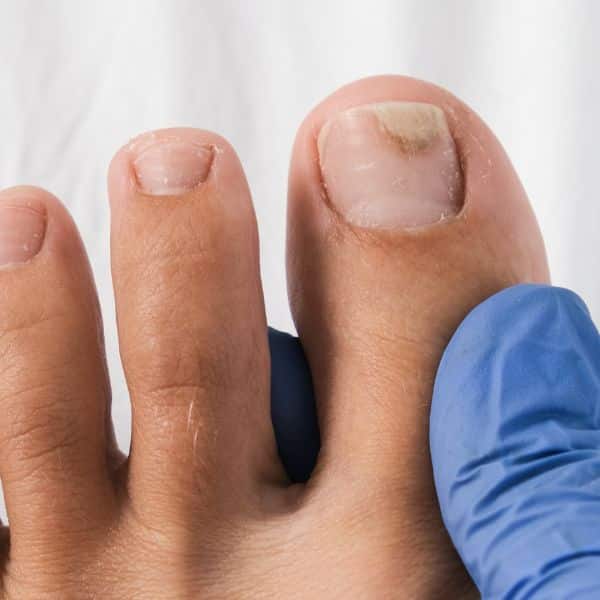Everyday life takes a toll on your feet. Between too-tight shoes, lots of walking, and other activities that cause repeated friction in the same areas of your feet, corns and calluses form. They’re hard, knobbly, dry and irritating patches of skin that can be very uncomfortable and can often make you self-conscious when wearing sandals or bearing your feet.
These days the internet is flooded with products and gadgets designed to help with corn and callus removal. Between the viral foot peel booties and the pedicure videos on TikTok there’s the distinct impression that whipping off a corn or callus is super easy. Many try to do it themselves at home, BUT, in reality corn and callus removal should only be completed by a professional for a few very good reasons. Here’s why you shouldn’t try to do it yourself…
The Risk Of Infection
The problem with all those viral videos of corns and calluses being removed is that they give a very unrealistic view of the procedure. For one thing, they are usually sped up a lot. You spend about 90 seconds watching the full sole of a foot be liberated from thick, tough calluses and you think ‘Huh, well that’s nice and easy, I can do that!’.
Next you have the issue that tools used in these videos are often sold on affiliate links from the video creator; this actively encourages people to buy their own bladed tools and start cutting their own feet.
Seriously, does this sound sensible? Trust us, it’s not! Unless you’re a trained professional you should not be taking any form of bladed instrument to your feet. In all likelihood you will not only cut the callus or corn you’re aiming for, but also healthy flesh. This will then easily become infected. You can rapidly end up with a far worse foot situation than you started with; one that requires strong antibiotics and weeks of pain to heal.
Accidental Injury
An extension of the risk of infection is the risk of accidental injury. While a small nick to the healthy flesh on your feet can cause infection – especially if you haven’t properly sanitised your instrument, hands and feet before starting – you are also dealing with a sharp blade.
Sharp blades lead to injury. When you haven’t been trained in how to safely remove a callus or corn the likelihood is your hand will slip while you’re trying to do it. Not only can you cut your foot, but you’re also exposing your hands, wrists, and ankles to that blade. Bear in mind you have veins very close to the skin in all these areas, and you quickly realise a cut could be very serious.
The Extreme Awkwardness Of Reaching The Soles Of Your Feet
Finally one of the less medical reasons to never try this yourself is that reaching the soles of your own feet is incredibly difficult. When you have a pro doing this procedure for you they can position your feet in the optimal way to ensure a firm grip, the right angle, ample lighting and various other factors. When you’re trying to reach your own soles you are very limited in your angle of approach, and many people aren’t flexible enough to reach them at all.
You think touching your toes is tough? How are you going to safely cut the soles of your feet? Yes, knees can be bent, you can sit comfortably, but it’s still a very awkward thing to attempt, and there will always be one side of each foot that you can’t reach as easily as the other.
If you’re thinking, “That’s okay, I’ll get someone else to do it for me!” we refer you back to the risk of infection and accidental injury, which is still a very real possibility if you’re having your mum, your friend, or your significant other try this for you.
Understanding Corns and Calluses
Corns and calluses are areas of thickened skin that develop to protect the skin and underlying tissue from pressure, friction, or injury. They typically form on the feet and toes or hands and fingers. Corns and calluses are not the same; corns are smaller, usually painful, and have a hard centre surrounded by inflamed skin, often forming on non-weight bearing parts of the foot like the tops and sides of toes or between toes where they rub together. Calluses are typically larger patches of rough, thick skin that develop on the soles of the feet or palms of the hands.
Formation of Corns and Calluses
The skin forms corns and calluses in response to repeated pressure or friction on specific areas. This is a protective mechanism to prevent the skin from wearing out. Factors contributing to their formation include ill-fitting shoes, high heels, playing instruments, or manual labour that puts repeated pressure on hands or feet.
Types of Corns
Hard Corns: These are the most common type of corns, usually found on dry, flat surfaces of the skin.
Soft Corns: Typically found between toes, these stay soft due to moisture from sweat or improper drying of feet.
Seed Corns: Small, discrete calluses that can be very tender and usually found on the bottom of the feet.
Understanding why corns and calluses form is crucial for preventing them and choosing the right treatment options.
Daily Foot Care Routine to Prevent Corns and Calluses
Maintaining a daily foot care routine can significantly help in preventing the formation of corns and calluses. Here are steps to incorporate into your daily regimen:
1. Choose the Right Footwear
Always wear shoes that fit well and provide adequate support. Shoes should not be too tight or too loose, and there should be enough room in the toe box.
Avoid wearing high heels for extended periods as they put excessive pressure on the toes and can lead to corn formation.
Consider using orthotic inserts for additional support where necessary.
2. Keep Feet Clean and Moisturized
Wash your feet daily with soap and warm water to keep them clean and free from infections.
After washing, thoroughly dry your feet, especially between the toes, to prevent soft corns from forming.
Apply a good foot moisturiser to keep the skin from drying out and cracking. However, avoid moisturising between the toes to prevent fungal infections.
3. Use Protective Padding
When doing activities that put pressure on your feet or hands, use protective padding to cushion the pressure points. For instance, gel pads for shoes can protect high-pressure areas under the feet.
In sports or certain activities, use custom padding to protect against repeated rubbing.
4. Perform Regular Foot Inspections
Regularly check your feet for areas of rough skin, tenderness, or changes in skin colour. Early detection can help manage these spots before they develop into full-blown corns or calluses.
If you have diabetes or another condition that causes poor blood flow to the feet, these inspections are crucial and should be done more frequently.
5. Exfoliate
Gently exfoliate the feet once a week to remove dead skin cells and prevent calluses from building up. Use a pumice stone or foot file, but be gentle to avoid damaging the skin.
6. Stay Hydrated and Maintain Healthy Nutrition
Hydration is key for maintaining skin elasticity. Drink plenty of water throughout the day.
Nutrition also plays a role in skin health. Ensure you get enough vitamins such as vitamin E and omega-3 fatty acids, which can improve skin condition.
By following these daily foot care steps, you can greatly reduce the risk of developing painful corns and calluses, keeping your feet healthy, comfortable, and ready for whatever the day brings.
The best way to ensure safe and successful corn and callus removal is to book an appointment at our clinic in Northwich and let us do it for you. We’ve been happily removing the corns and calluses of Cheshire residents for years; your feet will be in safe hands.





